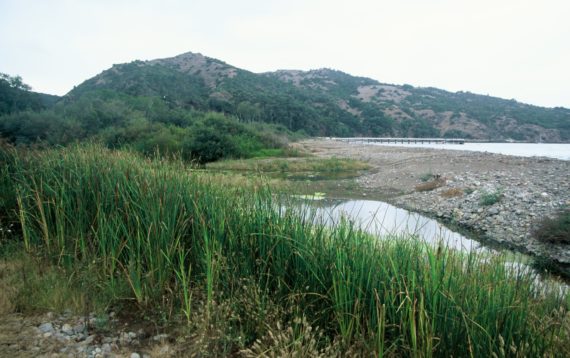Location: Santa Barbara County
Project Type: Restoration
Status: Completed
Habitat Type: Riparian, Tidal Wetland
Cost: $775,069
Area Affected: 50 acres
Assembly District: 37
Senate District: 19
Congressional District: 24
Project Lead/Grantee:
Channel Islands National Park (805-658-5784)
 For more information, visit scwrp.org
For more information, visit scwrp.org
This project restored a coastal wetland and one mile of a stream corridor at Prisoners Harbor and Canada del Puerto, the primary access point for Santa Cruz Island, Channel Islands National Park.
Prisoners Harbor on Santa Cruz Island sits at the mouth of Cañada del Puerto, a seasonal creek. Historically, the Prisoners area was once the largest coastal wetland on the Channel Islands. This rare habitat, comprised of a fresh water stream, coastal lagoon/wetland, and riparian woodland, provided respite from the long dry summers for a diverse array of species including the island fox. The wetland most likely served as a resting and feeding stop for migratory birds and nesting habitat for resident waterfowl.
To restore the natural function and ecology of the wetland, an engineering firm was contracted to remove the artificial fill from the wetland and reshape the landscape to its former condition. Using heavy equipment they removed a 250 feet of artificial berm that had been built up next to the stream, allowing it to flood naturally. The project, which extends over nearly 60 acres of land owned by the NPS and The Nature Conservancy, includes about four acres near the shore and nearly one mile of stream habitat in the valley. The project involved earthmoving, removal of non-native species such as eucalyptus, and planting of native riparian and woodland species. Ranching structures in the project area including, a scale house, loading chute, squeeze chute, and water trough were carefully relocated, and archaeological resources, were protected.
The return of natural function to the wetland is expected to increase the diversity and abundance of species particularly woodland birds, migratory waterfowl, amphibians such as Pacific tree frogs and salamanders. The increased water in the wetland will increase biological diversity due to more productivity and available food for wetland species. This will have a ripple effect throughout the food chain and other native animals like Santa Cruz Island fox will benefit.

